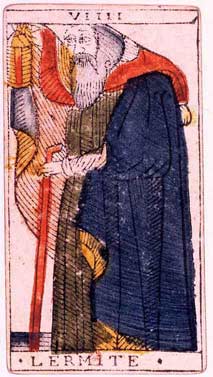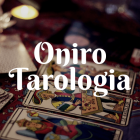Symbolism and meaning of the Hermit Tarot card
In this article we analyze the symbolism of the Hermit Tarot card and its meaning in a jungian perspective.
A game I love to play with people who do not know the Tarot is to let them choose the Tarot they like most in the deck. In the same way, I let them choose the Tarot card they consider the most “ugly”. It is a game that has a very superficial psychological value, however it can shed light on both unpleasant and potentially interesting “Shadow” aspects.
The Shadow, in Jungian psychology, corresponds to that part of us that has fallen into the unconscious. It is a part of us that is unpleasant, inadequate, not very functional for the purposes and aspirations of consciousness. The Shadow is a fragment of us that continues to live in dreams and, during the day, is projected onto other people.
Personally, the Tarot which I consider the most “ugly”, is the Hermit. Being fond of symbology, the Hermit is the Arcanum that definitely contains fewer objects and symbolic elements. It is a cold, little colored, uninteresting Arcane. But these are exactly the elements that characterize the symbolism of the Hermit of the Tarot. There must then exist in me “Shadow” elements that resonate with the Hermit. It is true, I recognize them, I will work on it, but this is not the subject of this article.

But if I have to highlight the most irritating aspect of the Hermit is his aura of solitude, of desolation. Yes, I know, these are also my Shadow aspects, but let us stick to the objective symbolism of this Arcanum.
What makes the Hermit so lonely, so bleak? The most obvious iconological element of the symbolism of the Hermit Tarot card is the lantern.
Subjective meaning of the Hermit Tarot card
But from a subjective point of view? How do I relate to the archetypal symbolism of the Hermit Tarot card? Which parts of me does the Hermit make resonate?
When observing the Tarot – and this is a very useful approach even when analyzing the objects and characters of our dreams – we need to appeal to all our four psychological functions: thinking, feeling, intuition, and sensation. So, let us not just rely upon what we think and feel about the object, but let’s try to empathize with it.
I therefore asked myself:
- What is the Hermit thinking of?
- What are his feelings?
- Where does he come from? Where is he going?
- What does he see? What does his senses tell him?
Here, it is precisely the question “what does he see?”, corresponding to the “sensing” function, which “clicked” something inside me, as it happens the sensation is my unconscious function, being I an Intuition type! There is an inextinguishable conflict between the functions of Intuition and Sensation: the intuitive types will always have great problems with the world of sensoriality, and vice versa.
The concept, in other words, can be understood if we think of the difficulty of having a good intuition (understood as the ability to glimpse new perspectives, new possibilities besides the status quo of the existing) if we are too entwined by the senses, if we live too wrapped up from the “sensory” and “sensual” manifestations of the matter. We find a mythological parallel with the episode of Ulysses who, bewitched by the earthly delights offered by the Goddess Circe, sees his companions (psychologically, a part of himself) turned into pigs. The purpose of his mission, to return home, is slowed down. In psychological terms, returning home means being reunited with one’s Self.
The conflict between intuition and sensation
With this idea of conflict between “intuition” and “sensation” in mind, let’s try to physically reconstruct the action that the Hermit is performing. Let’s focus on the “sensory” aspect of the symbolism of the Hermit Tarot card. Let us observe its attitude and body language. It can be useful and in his own way funny to exactly imitate his action, his posture. For example, let’s try to proceed slowly in a dark environment holding a source of light.
Have you ever tried walking in the woods at night, looking directly at the light of a flashlight, rather than looking at the surrounding partially illuminated by that light? Not only are you blinded, but you can’t see where you step on
Dream symbolism inspired by the Hermit Tarot card
The light of the lantern represents the tenuous light of reason, or in another way the fire of intuition. The Hermit then teaches that proceeding by contemplating the power of one’s mind not only does not throw light on the depths of the unconscious but is the best way to be swallowed up by it.
This is an aspect that recalls Jung’s youthful dream of the “Brocken Spectre”. (read here to learn more about the dream meaning of that dream). It is the impossibility to illuminate (and to lighten up?) if one does not remain in connection with his roots, that is, with the Devil Tarot card.
The Hermit walks by appealing only to intellectual faculties, to the point of being completely absorbed and losing sight of the path to follow. This is what makes the Hermit alone, lost, desolate. His “myopia” in overestimating the mind prevents him from adequately exploring the depths of the unconscious. It is in the depths of the earth, as handed down by the Alchemists, that the treasure is buried.
“Dear Hermit, stop staring at that lantern, lower it and use it to light up the ground!” This is the message I should address to my “inner Hermit”, an aspect of mine “eremitical” Shadow, of those who rely too often on the mind rather than enjoying the sensuality of the “here and now” offered by the earth and its fruits.
Suggestions for interpreting dreams
Another interesting aspect offered by the image of the Hermit regards some practical suggestions on how to relate to one’s dreams. Dreams belong to the “lunar” world. Their impalpable matter is likely to be “burned” if approached with the solar heat of thinking, trying to illuminate the darkness at all costs. In practice this means two things:
- Dreams can never be fully explained, and it is indeed a good thing that a part of the dream remains poorly lit. In this way its “energetic” content will continue to work in secret, as it is in the nature of the symbols: they have an inner motion produced by the interaction between something that is known to us and something that is unknown to us (the unconscious), juts like the two different horses of the Chariot Tarot card;
- When we analyze dreams, let us not be ensnared by overly “intellectual” explanations, but let’s try to approach the meaning of the dream with the “lower parts” of ourselves, appealing to our heart, our belly, our senses. That is with the spheres related to feeling and sensation.
I conclude by quoting in this regard a beautiful aphorism by Carl Gustav Jung: “where wisdom reigns, there is no conflict between thinking and feeling.”
In other words, the Hermit, which is also the archetype of the “Wise Old Man“, will be truly wise only by connecting the light of his lantern with the furrow traced by his stick in the depths of his heart.
Click here to learn more about the OniroTarology method.
